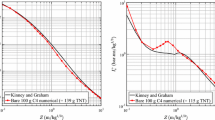Abstract
The detonation of a metalized explosive generates a complex multiphase flow field. Modeling the subsequent propagation of the blast front requires a detailed knowledge of the metal particle dynamics and reaction rate. Given the uncertainties in modeling these phenomena, a much simpler, 1D compressible flow model is used to illustrate the general effects of secondary energy release due to particle reaction on the blast front properties. If the total energy release is held constant, the blast pressure and impulse are primarily dependent on the following parameters: the proportion of secondary energy released due to afterburning, the rate of energy release, the location the secondary energy release begins, and the range over which it occurs. Releasing the total energy over a longer time period in general reduces the peak blast overpressure at a given distance. However, secondary energy release reduces the rate of decay of the shock pressure, increases the local gas temperature and hence increases the velocity of the secondary shock front. As a result, for certain values of the above parameters, the peak blast impulse may be increased by a factor of about two in a region near the charge. The largest augmentation to the near-field peak impulse results when the secondary energy is released immediately behind the shock front rather than uniformly within the combustion products.
Similar content being viewed by others
References
Balakrishnan K., Genin F., Nance D., Menon S.: Numerical study of blast characteristics from detonation of homogeneous explosives. Shock Waves 20, 147–162 (2010)
Balakrishnan K., Menon S.: On the role of ambient reactive particles in the mixing and afterburn behind explosive blast waves. Combust. Sci. Technol. 182, 186–214 (2010)
Brode H.L.: Blast wave from a spherical charge. Phys. Fluids 2(2), 217–229 (1959)
Combustion Dynamics Ltd., Halifax, NS, Canada: IFSAS II User Manual (2003)
Dewey J.M.: The properties of a blast wave obtained from an analysis of the particle trajectories. Proc. R. Soc. Lond. Ser. A Math. Phys. Sci. 324(1558), 275–299 (1971)
Donahue, L., Whitehouse, D., Josey, T., Ritzel, D., Winter P.: Non-ideal blast effects for vulnerability/lethality analysis. In: Proc 21st International Symposium on Ballistics, Adelaide, Australia (2004)
Fried L., Howard W., Souers P.: Cheetah 2.0 user’s manual, UCRL-MA-117541 Rev.5. University of California, LLNL, California (1998)
Kingery, C., Bulmash, G.: Airblast parameters from tnt spherical air burst and hemispherical surface burst. Tech. Rep. Report ARBL-TR-02555, U.S. Army BRL, Aberdeen Proving Ground, MD (1984)
Kinney G., Graham K.: Explosive Shocks in Air, 2nd edn. Springer, Berlin (1985)
Kuhl, A., Ferguson, R., Bell, J.: Thermo-Gas-Dynamic model of afterburning in explosions. In: Proc. 19th International Colloquium on the Dynamics of Explosions and Reactive Systems, Hakone, Japan (2003)
Lanovets V., Levich V., Rogov N., Tunik Y-.V., Shamshev K.: Dispersion of the detonation products of a condensed explosive with solid inclusions. Fizika Goreniya i Vzryva 26, 88–92 (1991)
Leadbetter, J., Ripley, R., Zhang, F., Frost, D.: Multiple energy scaling of blast waves from heterogeneous explosives. In: Proceedings of 21st International Colloquium on the Dynamics of Explosions and Reactive Systems, Poitiers, France (2007)
Needham C.: Blast Wave Propagation. Springer, Berlin (2010)
Ritzel, D., Matthews, K.: An adjustable explosion-source model for CFD blast calculations. In: Proceedings of 21st International Symposium on Shock Waves, Great Keppel Island, Australia (1997)
Ritzel, D., Ripley, R., Murray, S., Anderson, C.: Near-field blast phenomenology of thermobaric explosions. In: Proceedings of 26th International Symposium on Shock Waves, Gottingen, Germany (2007)
Sedov L.: The motion of air due to a strong explosion. Prikl. Mat. Mekh 10, 241 (1946)
Swisdak, M.: Simplified kingery airblast calculations. In: Minutes of the 26th DOD Explosives Safety Seminar (1994)
Tanguay V., Goroshin S., Higgins A., Zhang F.: Aluminum particle combustion in high-speed detonation products. Combust. Sci. Technol. 181, 670–693 (2009)
Tanguay V., Higgins A., Zhang F.: A simple analytical model for reactive particle ignition in explosives. Propellants Explos. Pyrotech. 32(5), 371–384 (2007)
Taylor G.: The formation of a blast wave by a very intense explosion. I. Theoretical discussion. Proc. R. Soc. Lond. Ser. A Math. Phys. Sci. 201(1065), 159–174 (1950)
Taylor G.I.: The air wave surrounding an expanding sphere. Proc. R. Soc. Lond. Ser. A Math. Phys. Sci. 186(1006), 273–292 (1946)
Zhang F., Frost D., Thibault P., Murray S.: Explosive dispersal of solid particles. Shock Waves 10, 431–443 (2001)
Zhang F., Gerrard K., Ripley R.: Reaction mechanism of aluminum-particle-air detonation. J. Propuls. Power 25(4), 845–858 (2009)
Author information
Authors and Affiliations
Corresponding author
Additional information
Communicated by E. Timofeev.
Rights and permissions
About this article
Cite this article
Zarei, Z., Frost, D.L. Simplified modeling of blast waves from metalized heterogeneous explosives. Shock Waves 21, 425–438 (2011). https://doi.org/10.1007/s00193-011-0316-0
Received:
Revised:
Accepted:
Published:
Issue Date:
DOI: https://doi.org/10.1007/s00193-011-0316-0




